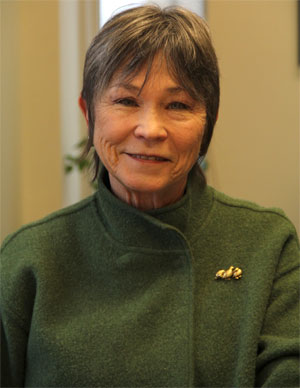Audiologist receives career research award
News
Dr. Brenda Ryals knows why the caged bird sings — or at least why the Belgian Waterslager canary can overcome a hearing impairment at birth to become one of the prized crooners of the avian world.
Ryals, professor of communication sciences and disorders at James Madison University and director of its Auditory Research Lab, has spent nearly two decades studying the canary’s and other birds' remarkable ability to regenerate sensory cells in the inner ear. Her work with psychologist Dr. Robert Dooling at the University of Maryland in the areas of neural plasticity and hearing development in birds has important implications for humans and is one of the highlights of a prolific research career.
For her many contributions to the advancement of auditory neuroscience, her service to the scientific community and her expert mentoring of students, Ryals is the recipient of the 2012 Jerger Career Award for Research in Audiology. She will be formally recognized by the American Academy of Audiology at its annual convention in Boston in March.
Ryals attributes much of her success in the field to “the privilege of working with smart, curious, interesting, good-hearted, fun people on a topic that I find endlessly absorbing.” To receive an award named for one of the founding fathers of audiology, Dr. James Jerger, “is just a huge honor,” she said.
Ryals’ passion for improving hearing is rooted in her boundless curiosity. “I’m just as curious as I can possibly be,” she said. “When I got my master’s degree [in 1973] at the University of Tennessee and went into clinical practice, I kept having questions. I would see a person and say ‘I’ve measured your hearing and this is what it looks like.’ But for me that’s just not enough. I wanted to know why their hearing was like that, can we make it better and how was it affecting their life.”
In the early 1970s, Ryals was still focused on diagnosing hearing loss in people, but her career path would soon take a turn. While in private practice in Norfolk, she began working with a neonatologist at the new Eastern Virginia Medical School who was concerned about babies in the neonatal intensive care unit who were losing their hearing after being given broad-spectrum antibiotics. “That’s when I became really interested in research and auditory development,” Ryals said.
A colleague at the medical school convinced her to pursue a doctoral degree, which led Ryals to the University of Virginia, which had lured renowned neuroscientist Edwin Rubel and his lab from Yale University. Rubel would become Ryals’ mentor, and he encouraged her to study birds if she wanted to better understand the connection between hearing development and the brain. “My academic career would have been very different if not for him,” she said.
In 1988, Ryals and Rubel were part of the research team behind the groundbreaking discovery that birds can regenerate their hair cells, which convert sound vibrations in the inner ear into electrical signals that travel to the brain via the auditory nerve. “It was really lucky that we discovered [that fact] at birth because birds sing, they use vocal communication,” Ryals said. “We thought, if we take away all the sensory cells in the ear, they all grow back and eventually get reintegrated to the brain, so how does that affect perception?”
Mammals cannot regenerate hair cells on their own, although gene therapy and stem cell research have shown promise in restoring hearing loss in laboratory animals and led National Institutes of Health-supported researchers like Ryals and Dooling to wonder if the same result is possible in people.
Ryals, who has been at JMU since 1989, also finds time to assist graduate students with their lab research on topics such as low-level distortion in the inner ears of birds and alternative methods for the delivery of hearing aids to people.
When she isn’t teaching or in the lab, Ryals puts her clinical skills to good use in places like Kenya and with groups such as Special Olympics International. She has also served on numerous scientific review panels for the NIH as well as the Scientific Review Board of the Deafness Research Foundation and the NIH/NIDCD National Research Advisory Council. She is a past president of the American Auditory Society and a former member of the executive board of the American Academy of Audiology, and is currently editor-in-chief of Ear and Hearing, the journal of the American Auditory Society.
“She’s a real ambassador for the field, and we’re very lucky to have her here,” said longtime friend and colleague Dr. Lincoln Gray, professor of communication sciences and disorders at JMU who, along with Ryals, directs Madison’s Au.D./Ph.D. program. “She’s one of the reasons I came back to Virginia” in 2005, he said.
Gray was a post-doctoral fellow at U.Va. in the late 1980s when Ryals and her team made their discovery — a seminal moment that he said went against everything audiologists had been taught. “When I was in grad school, we learned that once you lose your hearing, it’s like a severed foot, it’s gone,” he said. “So it’s quite remarkable that she even looked. It set up this whole industry of people trying to figure out how to get our hair cells to regenerate.”
Gray said Ryals is well deserving of the Jerger award, adding that if someone is finally able to take her research and develop an eardrop that will help restore human hearing, it could elevate Ryals to Nobel Prize status. “I think it will get the attention of the old men in Stockholm,” he said.
Related links:
* American Academy of Audiology, audiology.org/
* Department of Communication Sciences & Disorders

